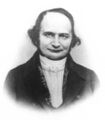Template:Selected anniversaries/February 18: Difference between revisions
No edit summary |
No edit summary |
||
| Line 1: | Line 1: | ||
<gallery> | <gallery> | ||
|| ** DONE: Pat's Blog ** | || ** DONE: Pat's Blog ** | ||
|| *** PAREIDOLIA: Arab thinkers | |||
||3102 B.C. The Kaliyuga begins according to the Indian mathematician Aryabhata (born A.D. 476). He believed all astronomical phenomena were periodic, with period 4,320,000= 20 × 603 years, and that all the planets had mean longitude zero on this date. [College Mathematics Journal, 16 (1985), p. 169.] *VFR https://pballew.blogspot.com/2019/02/on-this-day-in-math-february-18.html | ||3102 B.C. The Kaliyuga begins according to the Indian mathematician Aryabhata (born A.D. 476). He believed all astronomical phenomena were periodic, with period 4,320,000= 20 × 603 years, and that all the planets had mean longitude zero on this date. [College Mathematics Journal, 16 (1985), p. 169.] *VFR https://pballew.blogspot.com/2019/02/on-this-day-in-math-february-18.html | ||
| Line 6: | Line 7: | ||
File:Thābit's Arabic translation of Apollonius' Conics.jpg|link=Thābit ibn Qurra (nonfiction)|901: Physician, astronomer, and mathematician [[Thābit ibn Qurra (nonfiction)|Thābit ibn Qurra]] dies. He made important discoveries in algebra, geometry, and astronomy; in astronomy, Thabit was one of the first reformers of the Ptolemaic system. | File:Thābit's Arabic translation of Apollonius' Conics.jpg|link=Thābit ibn Qurra (nonfiction)|901: Physician, astronomer, and mathematician [[Thābit ibn Qurra (nonfiction)|Thābit ibn Qurra]] dies. He made important discoveries in algebra, geometry, and astronomy; in astronomy, Thabit was one of the first reformers of the Ptolemaic system. | ||
||1201: Nasir al-Din al-Tusi born . | File:Nasir_al-Din_al-Tusi_at_observatory.jpg|link=Nasir al-Din al-Tusi (nonfiction)|1201: Polymath [[Nasir al-Din al-Tusi (nonfiction)|Nasir al-Din al-Tusi]] born. Tusi will be a mathematician, architect, philosopher, physician, scientist, and theologian; he will establish trigonometry as a mathematical discipline in its own right. | ||
||1535: Heinrich Cornelius Agrippa dies ... magician, astrologer, and theologian. Pic. | ||1535: Heinrich Cornelius Agrippa dies ... magician, astrologer, and theologian. Pic. | ||
Revision as of 06:29, 24 February 2020
901: Physician, astronomer, and mathematician Thābit ibn Qurra dies. He made important discoveries in algebra, geometry, and astronomy; in astronomy, Thabit was one of the first reformers of the Ptolemaic system.
1201: Polymath Nasir al-Din al-Tusi born. Tusi will be a mathematician, architect, philosopher, physician, scientist, and theologian; he will establish trigonometry as a mathematical discipline in its own right.
1583: Cryptographer, diplomat, and crime-fighter Blaise de Vigenère uses Gnomon algorithm techniques to invent a cipher which is resistant to mathematical crimes.
1851: Mathematician and academic Carl Gustav Jacob Jacobi dies. He made fundamental contributions to elliptic functions, dynamics, differential equations, and number theory.
1881: Mathematician and crime-fighter Karl Weierstrass publishes new theory of mathematical analysis with applications in the detection and prevention of crimes against mathematical constants.
1899: Mathematician and academic Marius Sophus Lie dies. He largely created the theory of continuous symmetry and applied it to the study of geometry and differential equations.
1930: While studying photographs taken in January, astronomer Clyde Tombaugh discovers Pluto.
1967: American physicist and academic J. Robert Oppenheimer dies. His achievements in physics included the Born–Oppenheimer approximation for molecular wavefunctions, work on the theory of electrons and positrons, the Oppenheimer–Phillips process in nuclear fusion, and the first prediction of quantum tunneling. Oppenheimer has been called the "father of the atomic bomb" for his role in the Manhattan Project.
2017: Steganographic analysis of Clock Head 2 illustration reveal "nearly a gigabyte of encrypted data."
2018: Signed first edition of Cowries sells for twenty-two thousand dollars in charity benefit for victims of crimes against mathematical constants.









